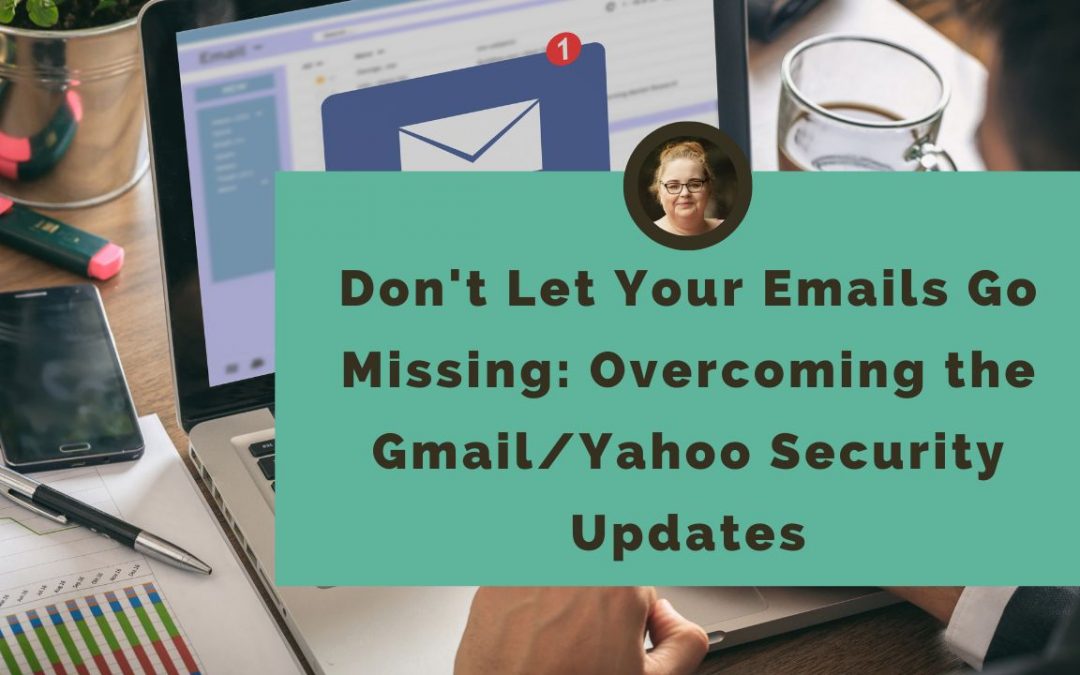Hey there, fellow small business owners, freelancers, solopreneurs, entrepreneurs and everyone else! This week’s blog is super important for all of us managing our marketing, so please read on and don’t let the latest Gmail/Yahoo Security Updates stop your emails from getting read…
So you may have heard there’s been a rumble in the email world, and Google and Yahoo are shaking things up with new security protocols. Don’t panic, though! This isn’t a doomsday scenario. It’s actually good news for everyone who plays fair in the email game.
Think of it like building a trust bridge between you and your customers. These new protocols are like tollbooths on that bridge, checking IDs and making sure everything’s legit. The goal? To keep spammers and phishers out and your awesome emails flowing freely.
So, why have the Gmail/Yahoo security updates happened?
Well, email has become the Wild West of online communication, with shady characters sending unwanted junk and pretending to be someone else. This not only annoys everyone, but it also hurts legitimate businesses like yours. These new protocols are like trusty sheriffs, cracking down on the bad guys and making the email highway safer for everyone.
How does this affect your email marketing?
If you’re a responsible sender, using your email list ethically and with proper permissions, then these updates are your friend. In fact, they’ll help your emails stand out from the spam crowd and land straight in your customers’ inboxes. But if you’re one of those “spray and pray” senders, well, prepare for a bumpy ride.
Here’s what you need to do:
Embrace SPF, DKIM and DMARC:
These email authentication heroes verify your identity and ensure your emails aren’t spoofed. Think of them as your email passport – gotta have them to cross the security border.
- SPF (Sender Policy Framework): Think of this as your visa. It tells email providers which mail servers are authorised to send emails on your behalf. It’s like listing the trusted border crossings for your email domain. Set up an SPF record by adding a TXT record to your DNS, specifying which servers can legitimately send emails for your domain.
- DKIM (Domain Keys Identified Mail): This one’s your digital signature. DKIM adds a unique cryptographic signature to your emails, proving they come from you and haven’t been tampered with during their journey. Imagine a custom watermark on your emails, ensuring authenticity. Set up DKIM by generating a signing key pair and adding a DKIM record to your DNS.
- DMARC (Domain-based Message Authentication, Reporting & Conformance): This is your travel itinerary, telling email providers what to do if your emails don’t have the proper SPF and DKIM visas. You can choose options like quarantining suspicious emails, rejecting them outright, or simply reporting them back to you. Think of it as your instructions for the immigration officer if your email passport isn’t in perfect order. Set up a DMARC record in your DNS, specifying your preferred policy for handling unauthenticated emails. As a side note, this one is more important if you’re sending more than 5000 emails at one time.
Taking Action:
- Don’t Panic: These protocols aren’t monsters! Most email marketing platforms can help you set up SPF, DKIM, and DMARC records with user-friendly interfaces. Many even offer free configuration tools.
- Seek Guidance: If you’re feeling overwhelmed, contact your email provider or platform support team. They should be happy to walk you through the process and answer any questions you might have.
- Testing is Key: Once you’ve set up your protocols, use online tools to test if your emails are correctly authenticated. This ensures you’re sending with a squeaky-clean passport before hitting the inbox highway. MailerTest is one tool you can use for free.
Clean Up Your List:
Remember that tidy house principle? A clean email list works the same way. Here’s what “cleaning up” your list entails:
- Identify the Inactive: Look for subscribers who haven’t engaged in a while (think: 6 months+ of no opens or clicks). Many email platforms offer segmentation tools to identify these folks.
- Say Goodbye with Grace: Don’t just delete them unceremoniously! Send a re-engagement campaign offering valuable content or asking if they still want to receive emails. If there is no response, then it’s time to say farewell. For me and my clients, I send a monthly re-engagement campaign and unsubscribe any that haven’t re-engaged the following week.
- Unsubscribe Made Easy: One click, that’s all it takes. Make unsubscribing painless with a clear link in every email. Remember, happy exits keep email providers happy.
- List Verification Tools: Consider using email verification services to identify invalid or outdated addresses before they land on your list. This prevents bounces and keeps your sender reputation high.
Content that Captivates, Not Clutters:
Sure, you have great products or services. But that doesn’t mean every email needs to be a sales pitch! Here’s how to make your content shine:
- Know Your Audience: Tailor your messages to their interests and needs. Segment your list based on demographics, purchase history, or website behaviour to send relevant content.
- Value Above All Else: Offer helpful tips, industry insights, or exclusive discounts. Show you care about their needs, not just your bottom line.
- Variety is the Spice: Mix up your formats! Go beyond plain text with engaging visuals, short videos, or interactive elements. Just keep it relevant and digestible.
- Personalisation Pays Off: Use subscribers’ names or purchase history to personalise your emails. It makes them feel valued and boosts engagement.
Unsubscribe with Ease:
No one likes feeling trapped! Make it easy for folks to leave if they no longer want your emails:
- One-Click Wonders: Ditch the complicated forms and confusing procedures. A single click should be all it takes to unsubscribe.
- Confirmation, Not Confusion: Let them know their request has been processed with a clear confirmation email or message. Transparency builds trust.
- Opt-Out, Not Out of Sight: Offer options to “unsubscribe” from certain types of emails instead of the whole list. This allows for flexibility and potentially keeps them engaged.
- Respect the Unsubscribe: Don’t try to re-engage people who have unsubscribed. It’s their decision, and respecting it protects your sender reputation.
Following these tips will build trust with your audience, improve deliverability, and make your email marketing magic shine!
Bonus Tips for Deliverability Domination:
- Warm Up Your Sending IP: If you’re new to email marketing, start slow and gradually increase your sending volume. Think of it as training your email muscles to avoid getting flagged as spam.
- Segment Your Audience: Tailor your emails to different groups of subscribers. People have different interests, so give them what they crave!
- Track and Analyse: Keep an eye on your email metrics to see what’s working and what’s not. Open rates, click-through rates, and unsubscribes are your performance indicators – use them to refine your strategy.
Conclusion
Remember, building trust with your audience and email providers is the name of the game. By following these tips and embracing the new protocols, you’ll ensure your emails land where they belong – in inboxes, not spam folders. If you have any questions or need help with your email marketing, please feel free to reach out to me at emma@moxycopy.co.uk.
So, a little about me: as a Virtual Marketing Assistant specialising in content and copywriting, helping businesses attract and nurture their ideal clients to grow their sales lights me up. So, drop me a message today if you need help identifying your perfect client, developing your messaging, or marketing your services.
Furthermore, if you’re having problems getting your emails opened, it could be your subject lines. So, I compiled 45 of my highest-performing subject lines, and you can grab them for FREE here.
You can also download my FREE guide to make SEO Easy. A handy desktop guide packed with quick and easy tips to get your business found online.

